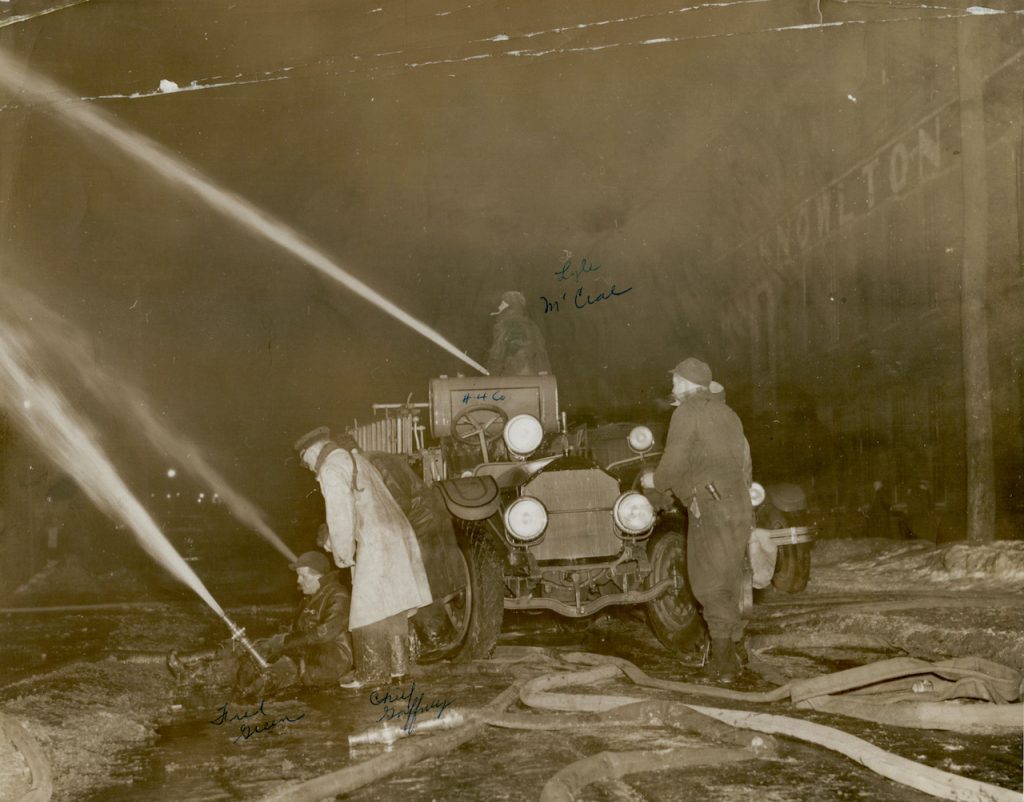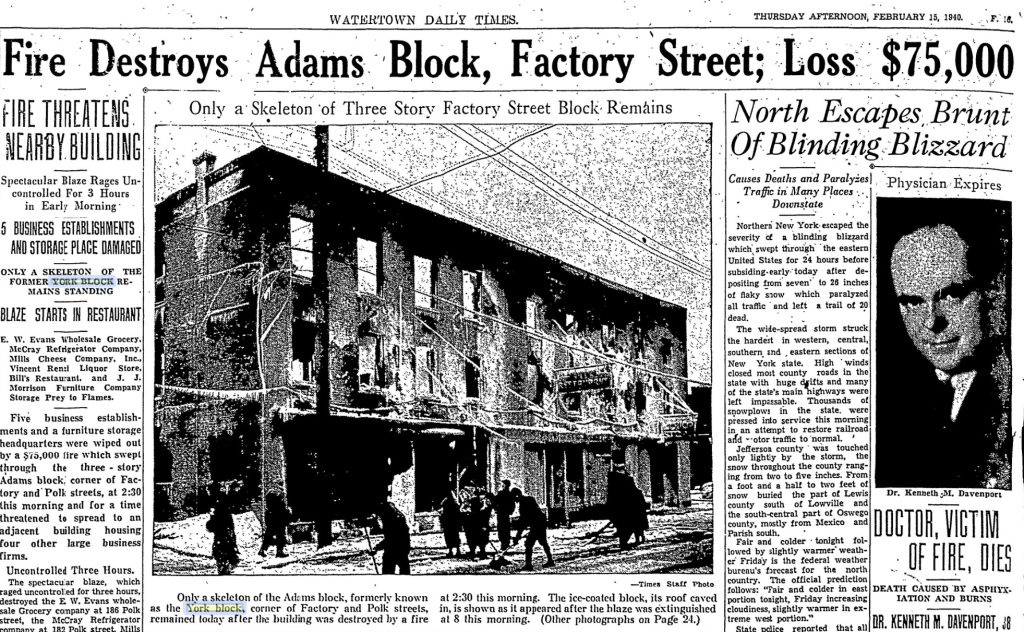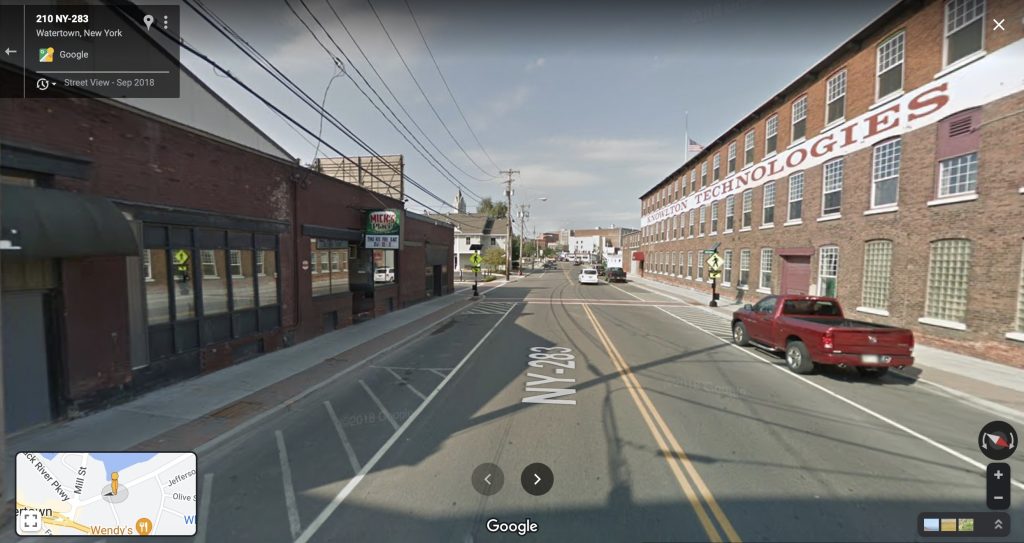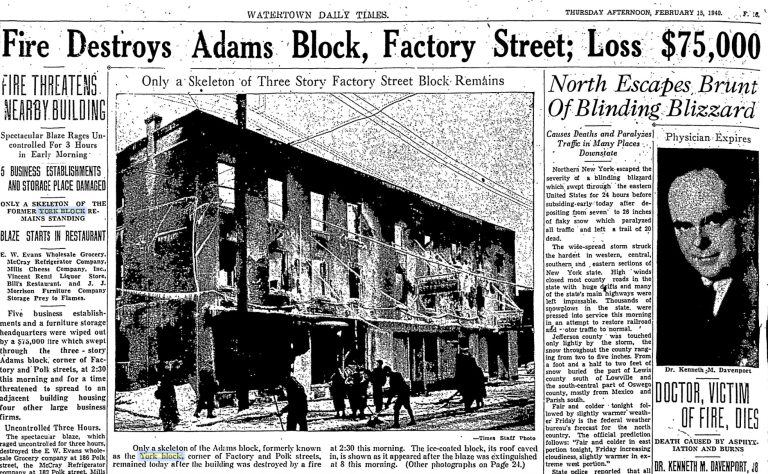Solving, and Building, A Mystery: Barney’s Place – Factory Street
Anywhere there’s hard work to be had, there’s a place nearby for a drink. Barney’s Place. Well, at least circa 1917. Factory street, during its heyday, had many well-established restaurants and watering holes like Colesante’s over the years, but placing “Barney’s Place” wasn’t exactly easy.

First off, the number on the back of the photograph was illegible, but “Factory Street” was easily decipherable. With little information to go on and nothing showing up on internet search results, the initial thought was perhaps it was what became known as “Smokey’s” in later years.
Nope!
A little more detective work proved to be fateful: always look at the reflections in the windows. Surely it had to be across from one of the manufacturers, the lettering in the window providing the initial guess of Smokey’s as it was located across from Factory Square.
Though it had been a couple of years since trying to solve this mystery, opening up the photo in a software program recently spurned the idea that lead to its answer: reversing the image so that the lettering read from left to right instead of backward. The result was the image below, which provided a big clue:

As can be clearly seen in reverse, “..R Brake Company,” none other than the New York Air Brake Company. By this time, the NYAB had relocated from Beebee Island to the corner of Starbuck Ave and Pear Street, opposite the Pearl Street School. But, digging through early 1900’s city directories showed its location as being in the 30-40 range of Factory Street.
Fortunately, another search for “Barney’s Place” proved fruitful: a 1917 brief advertisement for a fish fry in the Watertown Daily Times… but the street number was illegible. Turning the attention to the Elks Jubilee on July 30th poster in the window, a search affirmed the photo was taken in 1917.
With that information in hand, turning to the City Directory the year prior showed the numbering of Factory Street had indeed changed by then and that the New York Air Brake address was now 211 – 223 on the north side of Factory Street. That would finally lead us to determine that Barney’s Place is, or was, in most recent years, became Mick’s Place. Mystery solved! But it leads to more questions further below.

It’s not known how long Barney’s Place lasted. It’s address in 1917 was confirmed to be 210 Factory street, but subsequent searches in following years showed Morrison’s Furniture as the business listed at the address as perhaps the result of another street re-numbering effort, which wasn’t unusual during the era. Nevertheless, we’ll always have this cool photo!

Update: How Did The York Block Become A Single Story Building?
After posting the original story, a reader mentioned in the comments postulated if the location was the scene of the gruesome murder, which I suspected to be the Cesaro Badolato Murder. I continued searching because the three vs. one story issue didn’t make sense. What I found was there was a fire in February of 1940. I also realized I had a copy of a photo from it, shown above.

Even then, I didn’t realize it was the same building until researching the history of the building knowing that it is soon to be demolished. As noted in the photo above, the name had changed to the Adams Block some years prior. Researching the fire itself, one of the articles published on February 15, 1940 detailed the building’s history–
Tangible history of the old York block, or Adams block at 202-212 Factory Street as it has been known for the past 20 years, is more or less elusive from the sources available today. It is believed to date back more than three-quarters of a century to Civil War days.
Stone’s Jefferson County atlas of 1864 shows a long building on the site owned by H. & E. F. Cooper. City directories of an earlier date fail to disclose how much prior to that year the building was there. However the 1830-35 map of Watertown prepared by the late Dr. Avery Thomas and the late John Calhoun Sterling, father of John Sterling, shows the residence of Coll. A. Thomas on the site at that period.
While there is no corroborative information today at hand it is believed the structure was erected by the Coopers about 1860. That firm was composed of Howell cooper and his brother, Elias F. Cooper. They were engaged in the hardware business in the old Iron Block at 2 Public Square.

The York Block, it was also written, occupied space on the south side of Factory Street from Polk Street to Burns alley. In 1914, the property was disposed of to James L. Greene, who had his wholesale liquor store on part of the ground floor. The upper floors, for several years at that point, had been rented out as low-priced apartments.
The other article from February 15, 1940, gave details of the fire, which was described as the city’s worst in recent memory. Every piece of the Watertown Fire Department’s fire apparatus was put into use as the blaze raged for several hours. The department was called back on two occasions when the fire flared again.

Five business establishments and a furniture storage headquarters were wiped out by a $75,000 fire which swept through the three-story Adams Block, corner of Factory and Polk streets, at 2:30 this morning and for a time threatened to spread to an adjacent building housing four other large business firms.
The spectacular blaze, which raged uncontrolled for three hours, destroyed the E. W. Evans wholesale Grocery company at 186 Polk Street, the McCray Refrigerator company at 182 Polk Street, Mills Cheese Company, Inc., at 186 Polk Street, the Vincent Renzi liquor store at 202 Factory Street, Bill’s Restaurant at 206 Factory Street and the J. J. Morrison Furniture warehouse at 230 Factory Street. All of these firms were located on the main floor, the other two floors being used as storage space.

Although the building was considered totaled, the skeletal remains, meaning the walls, continued to stand after the ceiling had caved in. Four years later, “the easterly half of the old York Block” was sold to Joseph S. Chalk, who planned to erect a modern wholesale and retail store at the location. Apparently, rather than building anew, the property’s two upper levels, having their floors cave in, were demolished, and the ground floor was refurbished within the existing walls.
Over the years since, many businesses have operated in the building. The Commodore Restaurant on Public Square moved to 204 Factory Street in October of 1952, continuing for another 25 years before its new owner rebranded it in 1977. Studio 1 was known as a restaurant/pub with slide shows and silent movie viewings until the mid-1980s.

In 1987, it became Le Jardin Restaurant which lasted about a year before it was renovated and reopened as the “New Commodore” by Robert E. Soluri, Jr., who also operated two Soluri’s Pizzerias as well.
1992 saw Double Play, The Locker Room & Sgt.’s Pub in 1996 (the pub a division of Sgt. Pepperoni.) Finally, Mick’s Place had its grand opening on December 10, 1999, its name, perhaps intentionally so, harkening back to Barney’s Place.
In 2022, Knowlton Technologies, located opposite the old block building on Factory Street, purchased it with the intention of expanding their parking lot located on the Polk Street side near their property there. By mid-December, the memories were being served the last call before the wrecking ball struck.



















1 Reviews on “Barney's Place – Factory Street c. 1917”
There was a nasty murder outside one on the Factory Street bars back in that era. Was it Barney’s?
It was almost the same spot, but 13 years apart as the murder happened in 1904. Something must have happened to the building there, as it’s no longer three stories – which would also help explain the street renumbering in the area between 1904 and 1917. I’ll have to dig around and see what block building it was, though the York Block was named as being across the street. Here’s a link to the murder you’re referencing. Actually, if you scroll a bit further down, it shows up in nearby places at the bottom of the page, too.
So, apparently the York Block was the location of the bar in question. It was badly damaged in a 1940 fire, but, from what I’m gathering, despite the hefty damage, the bottom floor must have still been redeemable. At various points in time through about 1944, it was written as if it still existed. Then, in that year (1944), the property, which was stated as “the easterly half destroyed by fire” was purchased with the intent of building a new modern facility in its place. I’m guessing, having not found anything further regarding a new building, they instead salvaged what they could – the bottom floor – because there’s no way anything in that block between Polk Street and Morrison’s was built post-1944.